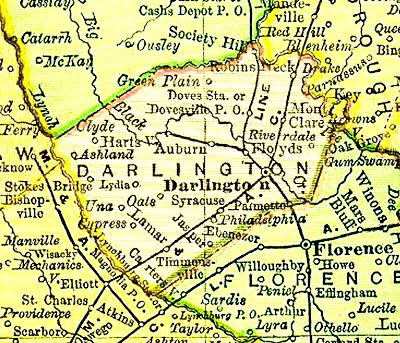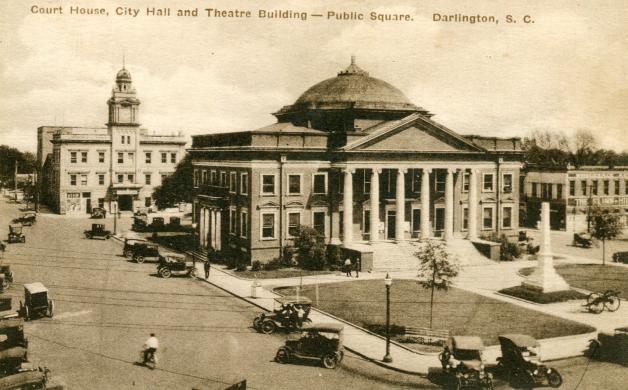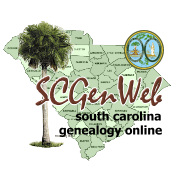Early history
This area was settled in the mid-18th century by Welsh, Scotch-Irish,
and English farmers, who grew cotton primarily.
The settlement of what is now Darlington County began in earnest
after 1736 and 1737 when the province of South Carolina set aside a vast
area of land for the Welsh Baptists of Delaware. This Welsh Tract bordered both sides of the Pee Dee River.
Soon after the first settlers began to arrive they constituted the Welsh
Neck Baptist Church. This church was first located on the north side of
the Pee Dee River, opposite present-day Society Hill. For almost thirty
years settlers concentrated on the banks and small tributaries of the
Pee Dee River. Beginning in the 1760s and continuing into the 1770s
other groups slowly made their way into present-day Darlington and were
granted lands on the Lynches River, Jeffries Creek, and a host of other
watercourses. These later settlers included descendants of French
Huguenots, Scots-Irish, and the English.
Delaware. This Welsh Tract bordered both sides of the Pee Dee River.
Soon after the first settlers began to arrive they constituted the Welsh
Neck Baptist Church. This church was first located on the north side of
the Pee Dee River, opposite present-day Society Hill. For almost thirty
years settlers concentrated on the banks and small tributaries of the
Pee Dee River. Beginning in the 1760s and continuing into the 1770s
other groups slowly made their way into present-day Darlington and were
granted lands on the Lynches River, Jeffries Creek, and a host of other
watercourses. These later settlers included descendants of French
Huguenots, Scots-Irish, and the English.
For three decades following the arrival of the first settlers, local
government did not exist for the citizens of the area. All deeds, estate
settlements, and other legal matters had to be taken to Charles Town to
be recorded. In 1769, by an Act of the Assembly, Cheraw District was
established as a Judicial District. A courthouse and gaol (jail) were
built at Long Bluff (near present-day Society Hill) and were operational
by late 1772.
After the Revolutionary War, in 1785, Cheraw District was divided
into three counties, Marlborough, Chesterfield, and Darlington.
Darlington County was bounded by Cedar Creek, the Pee Dee River, and
Lynches Creek (River). To this day there is uncertainty concerning why
the county was named "Darlington". A new county seat was established
near the center of the county, Darlington Court House. After 1798 the
designation "county" was changed to "district". In the 1868 South
Carolina Constitution, the designation reverted to county.
Florence County was created out of parts of Darlington and Marion
counties in 1888. Darlington County lost additional territory in 1902
when Lee County was created.

Darlington Court House and Public Square
The public square and the courthouse now sit in their present
location because of an argument between two men, Colonel Lamuel Benton
and Captain Elias Dubose, in the late 18th century. The tale goes that
the disagreement began over whether the courthouse should be located in
Mechanicsville or Cuffey Town. It was said that the two compromised,
each beginning in their town traveling on horseback until reaching one
another. The spot where they met is now the site of the Darlington
public square and courthouse. A fire in March 1806 destroyed the
original courthouse. It was rumored at the time that an old woman was
responsible for the flames in an attempt to burn papers connected to her
coming court case. Between 1824 and 1825 it was rebuilt with brick due
to a petition to build all buildings on the public square in brick to
prevent the spread of fire.
Historic sites
The Cashua Street-Spring Street Historic District, Julius A. Dargan
House, Darlington Downtown Historic District, Darlington Industrial
Historic District, Darlington Memorial Cemetery, Dove Dale, First
Baptist Church, Nelson Hudson House, Manne Building, Clarence McCall
House, Charles S. McCullough House, Oaklyn Plantation, St. John's
Historic District, South Carolina Western Railway Station, West Broad
Street Historic District, Wilds-Edwards House, and Mrs. B.F. Williamson
House are listed on the National Register of Historic Places.
text...from Wikipedia
Surrounding Counties:
Chesterfield |
Florence |
Kershaw |
Lee |
Marlboro
CONFERENCE KEEPER >
CALENDAR FOR SOUTH CAROLINA
IMPORTANT
INFORMATION
The South Carolina Department of Archives and History has released
11,000+ Revolutionary War Records
|





